If you change your mind after installing Windows 11, the clock is ticking

When Windows 11 is released, there will be millions of people scrambling to upgrade. There will undoubtedly be a huge number of people moving to the latest version of Windows, but there will be some who regret the upgrade and decide they preferred Windows 10.
No problem, you might think. A quick uninstall is all it will take to return to the fuzzy, warm comfort of Windows 10. And this is true... but there's a time limit if you’re looking for the easy route out.
See also:
- An upgrade from Windows 7 to Windows 11 will have to be a clean install
- This registry hack lets you bypass the TPM 2.0 requirement and install Windows 11
- Windows 11 could spell the end of the Blue Screen of Death
After installing Windows 11, the clock starts ticking. You have just 10 days to roll back to Windows 10 and retain all of your data, settings and documents. Of course you can still return to Windows 10 after this 10-day grace period is up, but you'll have to perform a clean install and rely on backups to restore your files manually.
Microsoft has not made a big deal about this. After all, the company will be keen for as many people as possible to stick with its latest and (in its opinion) greatest operating system. But in the Windows 11 section of the Microsoft site is a list of frequently asked question, one of which is:
Can I go back to Windows 10 after I upgrade if I don’t like Windows 11?
And the answer that’s given is:
Yes. After you have installed the Windows 11 upgrade, there is a 10-day period where you can move back to Windows 10 while keeping files and data that you brought along with you. After the 10 days, you will need to back up your data and do a “clean install” to move back to Windows 10.
So the advice is to ensure that you create a backup before upgrading to Windows 11. That way, if you change your mind about the operating system, you’ll not have a race against time to roll back.